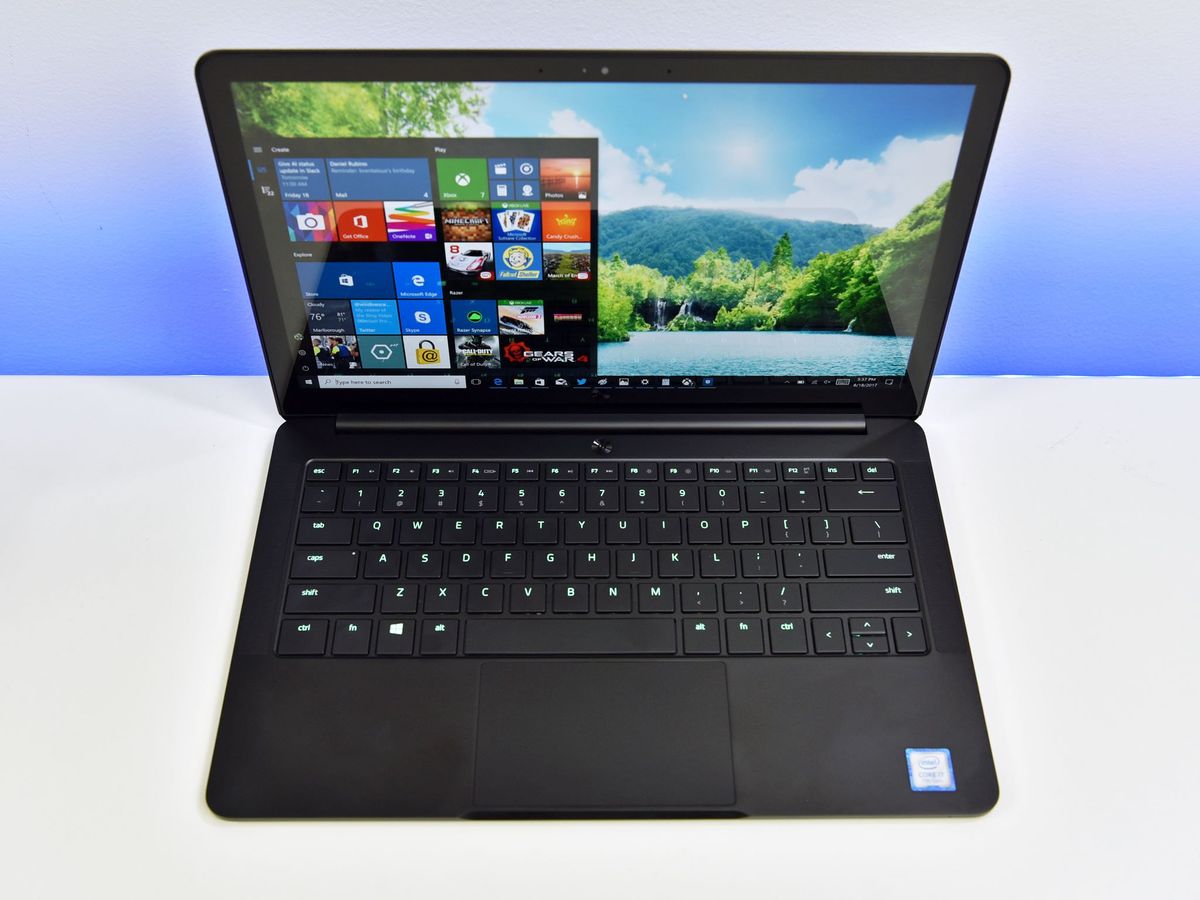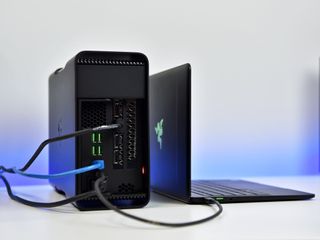Latest Razer Blade Stealth gets new quad-core CPU but battery disappoints
Razer is keen on updating its laptop line, with its premium Blade Stealth Ultrabook nabbing the latest eighth-generation Intel quad-core processor. While it helps with the overall experience, battery life is below average.

Razer reformulated its ultraportable Blade Stealth laptop in mid-2017 with display bezels that were 50 percent thinner, a new Microsoft Precision touchpad, and a gunmetal gray variant.
Razer likes to update its laptops with the latest Intel processors, which is great for consumers who want the best, but it may rub you the wrong way if you just bought last month's model.
That's the case with the Razer Blade Stealth late-2017 edition, which trades in its dual-core i7-7500U processor for a new quad-core i7-8550U. The RAM also gets a needed speed bump.
So how does it hold up? Check out our quick re-review in the video above.
Razer Blade Stealth specifications
Not much has changed from the mid-2017 Razer Blade Stealth, which I thoroughly reviewed back in August.
| Category | Razer Blade Stealth 2017 |
|---|---|
| OS | Windows 10 Home 64-bit |
| Material | CNC-machine aluminum single chassis design |
| Processor | Intel Core i7-8550U 1.8 GHz / 4.0 GHz (Base/Turbo) |
| Storage | 256 GB, 512GB, or 1TB PCIe NVMe SSD |
| RAM | 16GB LPDDR3- 2,133MHz (Fixed) |
| Display | 13.3" IGZO Touch Screen16:9 aspect ratio3200 x 1800 QHD+ |
| Graphics | Intel UHD Graphics 620 |
| Ports | One Thunderbolt 3 (USB-C)Two USB 3.0 port (SuperSpeed)One HDMI 2.0a3.5mm headphone/microphone |
| Audio | Top-firing stereo speakersDolby Digital Plus Home Theater Edition |
| Wireless | Killer Wireless-AC 1535 (802.11a/b/g/n/ac + Bluetooth 4.1) |
| Keyboard | Razer Chroma anti-ghosting keyboard with individually backlit keys |
| Camera | 720p |
| Battery | 53.6 WHr45W USB-C power adapter |
| Weight | 2.93 lbs. / 1.33 kg |
| Dimensions | 0.52 x 12.6 x 8.1 inches13.1 x 321 x 206 mm |
| Price | $1,499 to $2,099 |
The main differences come down to the upgraded processor, which is still Intel's 15W model for Ultrabooks, but it now has four cores instead of two. That processor can also idle at lower speeds (1.8GHz) and burst to new levels (4.0GHz) compared to the older version, which idled at 2.7GHz and turbos only to 3.5GHz.
Razer has also bumped the RAM to a more performant 2,133MHz, which while minor is still welcome.
Get the Windows Central Newsletter
All the latest news, reviews, and guides for Windows and Xbox diehards.
Razer Blade Stealth performance
There is nothing but good news when it comes to performance. The Blade Stealth is still very much an Ultrabook even if it looks like a proper gaming laptop. That means its Core i7 processor can handle standard Windows tasks just fine, but it will struggle when running any intensive PC game.
For those who like to game, though, Razer is hoping you'll want its external GPU system called Razer Core, which can handle up to an NVIDIA GTX 1080Ti graphics card. Running that full system will set you back a lot of money, but I'd be lying if I told you it wasn't extremely enjoyable. While it doesn't solve the problem for gaming on the go, it does let you own a premium Ultrabook that doubles as a serious gaming PC for when you're home and relaxing.
CPU
Geekbench 4.0 benchmarks (higher is better)
| Device | CPU | Single core | Multi core |
|---|---|---|---|
| Razer Blade Stealth (New) | i7-8550U | 4,567 | 14,095 |
| Razer Blade Stealth (Old) | i7-7500U | 4,211 | 8,333 |
| Dell XPS 13 (9360) | i7-8550U | 4,690 | 14,334 |
| Dell XPS 13 (9360) | i7-6560U | 4,120 | 7,829 |
| Surface Book 2 13 | i7-8650U | 4,862 | 14,694 |
| Surface Laptop | i7-7660U | 4,714 | 9,535 |
| HP EliteBook x360 G2 | i7-7600U | 4,496 | 8,435 |
| Samsung Notebook 9 15 Ext | i7-7500U | 4,316 | 8,320 |
The refreshed 8th generation Intel processor boosts the single core speed by a nice amount, but it's the multi-core score that sees the biggest boost.
GPU
Geekbench 4.0 OpenCL (higher is better)
| Device | GPU | Compute score |
|---|---|---|
| Razer Blade Stealth | UHD 620 | 22,274 |
| Razer Blade Stealth | HD 620 | 20,092 |
| Surface Book Perf. Base | GTX 965M | 64,108 |
| Surface Laptop i7 | Iris 640 | 31,010 |
| Surface Pro 2017 | Iris 640 | 30,678 |
| Lenovo Legion Y720 | HD 630 | 20,878 |
| Dell XPS 13 (9360) | HD 620 | 19,410 |
| Surface Book | HD 520 | 18,197 |
The Razer Blade Stealth gets a small graphics boost with the newer Intel UHD 620 component compared to the mid-2017 model running the Intel HD 620.
SSD
CrystalDiskMark (higher is better)
| Device | Read | Write |
|---|---|---|
| Raze Blade Stealth | 1,375 MB/s | 1,321 MB/s |
| Raze Blade Stealth | 1,281 MB/s | 1,330 MB/s |
| Dell XPS 13 9360 | 1,368 MB/s | 847 MB/s |
| Surface Book 2 13 | 1,411 MB/s | 1,202 MB/s |
| Surface Laptop | 423 MB/s | 237 MB/s |
| Lenovo X1 Carbon | 1,518 MB/s | 1,188 MB/s |
| Samsung Notebook 9 Ext | 1,365 MB/s | 1,213 MB/s |
| HP EliteBook x360 G2 | 1,129 MB/s | 916 MB/s |
| HP Spectre x360 15 | 1,128 MB/s | 862 MB/s |
Our review unit is running a Samsung PM9610 SSD, which is a premium storage solution. The read and write speeds reflect this choice by Razer and it gives excellent performance.
Razer continues to use premium parts in the Blade Stealth making the overall experience enjoyable. The fast processor, RAM, and a solid-state drive (SSD) help justify the steep cost.
Razer Blade Stealth remains an solid Ultrabook

There are much cheaper Ulltrabooks on the market, but Razer has carved out a nice niche for itself with a premium, unique design and quality components. The Blade Stealth is just fun to use. Performance is great for this class, the port selection is good, you get a full Thunderbolt 3 USB Type-C jack, and the display and trackpad are top notch.
Where the Blade Stealth stumbles is battery life, which falls just below eight hours. That's not actually terrible considering how thin and light the Stealth is, but it is below that of other Ultrabooks in this category. Likewise, the keyboard is a bit on the shallow side for typing, though it still ranks high for my usage.
The original Blade Stealth never impressed me, but the mid-2017 and now late-2017 editions have changed that perception. The Blade Stealth is one of the nicest Ultrabooks you can get, but it's not for everyone.
Your best bet, like all laptops, is trying to find one in a store like Best Buy or Microsoft to try it out yourself. But if you're looking for something a bit different and the feature set meets your expectations, the Blade Stealth is still forging its path. Let's just hope for better battery life next time around.
Pros:
- Excellent display.
- New Intel processor performs great.
- Outstanding build quality and design.
- Precision touchpad and 16GB of RAM.
- Full Thunderbolt 3 for eGPU.
Cons:
- Traditional laptop design.
- There are many cheaper alternatives.
- Battery life just below eight hours.
- No Windows Hello.

Daniel Rubino is the Editor-in-chief of Windows Central. He is also the head reviewer, podcast co-host, and analyst. He has been covering Microsoft since 2007 when this site was called WMExperts (and later Windows Phone Central). His interests include Windows, laptops, next-gen computing, and wearable tech. He has reviewed laptops for over 10 years and is particularly fond of 2-in-1 convertibles, Arm64 processors, new form factors, and thin-and-light PCs. Before all this tech stuff, he worked on a Ph.D. in linguistics, performed polysomnographs in NYC, and was a motion-picture operator for 17 years.